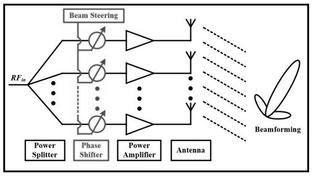Understanding Radar Absorbing Material (RAM) and Paint
Advertisement
This page covers the basics of Radar Absorbing Material (RAM) and Radar Absorbing Paint. It also mentions vendors, manufacturers, and suppliers of these materials.
Absorbers, in general, are classified into two main types:
- Impedance matching absorbers
- Resonant Absorbers
Types of Radar Absorbing Material
As we know, when a propagating wave is incident on an absorbing interface, it will get reflected. The magnitude of reflection depends on the incident waveform and the absorbing medium. Based on these factors, there are three main types of radar absorbing materials. These types are manufactured to reduce the impedance step between the incident media and the absorbing media.
- Pyramidal
- Tapered
- Matched image

Pyramidal Absorbers
This type provides a gradual impedance transition from air to the absorber. The shape of a pyramidal absorber is shown in the figure above. As shown, it is a cone-like structure perpendicular to the surface. The height and periodicity of the structure are about 1 wavelength long. This type of radar absorbing material has an operating frequency above which it provides very high attenuation.
Tapered Loading Absorbers
This type is advantageous over the pyramidal type due to its thin size. However, they offer poorer performance, so it is desired to vary the impedance gradient over one or more wavelengths. The material is made of a combination of low-loss and lossy materials. The lossy part is dispersed parallel to the surface with its gradient perpendicular to the surface, which increases into the body of the material.
Matching Layer Absorbers
The purpose of this type is to reduce the thickness compared to the types above. This type of absorber uses an absorbing layer in between the incident and absorbing media. The impedance of this transition layer is between the front and rear layers.
Resonant Materials
These materials are known as tuned absorbers or quarter-wavelength absorbers. This category includes the Dallenbach layer absorber, Salisbury Screen, and Jaumann absorber.
Circuit Analog Radar Absorbing Material (RAM) and Magnetic RAM
Initially, Jaumann and Salisbury absorbers were developed using only resistive sheets. Later on, capacitive and inductive materials were added to achieve broadband performance. These are known as resonant absorbers.
Magnetic Radar Absorbing Material
This material is made of carbonyl iron as well as hexaferrites. This type can absorb frequencies in the MHz and GHz frequency ranges.
Other Absorbing Materials
| Radar Absorbing Material | Description |
|---|---|
| Carbon | Anechoic chambers use absorbers made of coating mats of animal hair mixed with carbon black. |
| Metal and Metal Particles | Broadband absorbers are made of solid aluminum metal particles or other metals such as iron oxide, powdered iron etc. |
| Polypyrrole | It is very stable in air. It is used along with other materials such as latex, polymer blends and fibers. |
| Polyaniline | It is very inexpensive and readily available. It is a conducting polymer widely used in absorber fabrication. |
Radar Absorbing Material and Paint vendors, manufacturers, suppliers
Following are the manufacturers of Radar Absorbing Material and Paint:
- ARC Technologies
- Powder Processing & Technology, LLC
- IDSI Products, Inc.
- NACCO Aerospace
- Holland Shielding Systems
- Laird Technologies
 RF
RF

